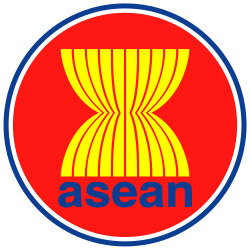| Emblem of the Association of Southeast Asian Nations | |
|---|---|
 | |
| Alternative name | The ASEAN Emblem |
| Adopted | 1979 (original emblem) 1997 (current iteration) |
| Shield | Set upon a red circle background, ten yellow paddy or rice stalks are drawn in the middle. Under the rice stalks the organisation name abbreviation "asean" is written in lower case Helvetica font in blue. The red circle is drawn with a white and blue circumference. |
The Emblem of the Association of Southeast Asian Nations, also known as the ASEAN Emblem or ASEAN Logo, is the emblem of ASEAN adopted in 1979.
Contents
The current iteration was adopted on 31 May 1997 together with the ASEAN flag. [1]